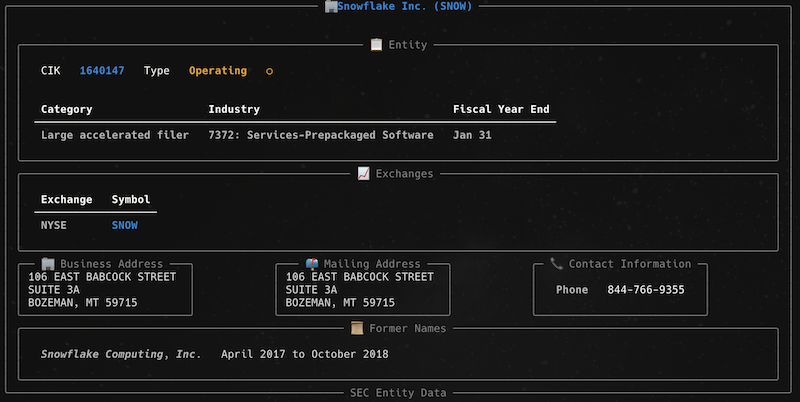Company API
With the company API you find a company using the cik or ticker. From the company you can access all their historical filings, and a dataset of the company facts. The SEC's company API also supplies a lot more details about a company including industry, the SEC filer type, the mailing and business address and much more.
Find by Ticker
c = Company("AAPL")
Tickers are case-insensitive so you can use Company("aapl") or Company("AAPL")
Find by CIK
The cik uniquely identifies a company or entity at the SEC.
c = Company(320193)
CIKS can also be strings which may or may not be zero padded to 10 places.
c = Company("0000320193")
# OR
c = Company("320193")
Find a company using the cik
The cik is the id that uniquely identifies a company at the SEC. It is a number, but is sometimes shown in SEC Edgar resources as a string padded with leading zero's. For the edgar client API, just use the numbers and omit the leading zeroes.
company = Company(1318605)

Find a company using ticker
You can get a company using a ticker e.g. SNOW. This will do a lookup for the company cik using the ticker, then load the company using the cik. This makes it two calls versus one for the cik company lookup, but is sometimes more convenient since tickers are easier to remember that ciks.
Note that some companies have multiple tickers, so you technically cannot get SEC filings for a ticker. You instead get the SEC filings for the company to which the ticker belongs.
The ticker is case-insensitive so you can use Company("snow")
or Company("SNOW")
snow = Company("snow")

Company(1832950)
Get filings for a company
To get the company's filings use get_filings(). This gets all the company's filings that are available from the Edgar submissions endpoint.
company.get_filings()
Filtering filings
You can filter the company filings using a number of different parameters.
class CompanyFilings:
...
def get_filings(self,
*,
form: str | List = None,
accession_number: str | List = None,
file_number: str | List = None,
is_xbrl: bool = None,
is_inline_xbrl: bool = None
):
"""
Get the company's filings and optionally filter by multiple criteria
:param form: The form as a string e.g. '10-K' or List of strings ['10-Q', '10-K']
:param accession_number: The accession number that uniquely identifies an SEC filing e.g. 0001640147-22-000100
:param file_number: The file number e.g. 001-39504
:param is_xbrl: Whether the filing is xbrl
:param is_inline_xbrl: Whether the filing is inline_xbrl
:return: The CompanyFiling instance with the filings that match the filters
"""
The CompanyFilings class
The result of get_filings() is a CompanyFilings class. This class contains a pyarrow table with the filings
and provides convenient functions for working with filings.
You can access the underlying pyarrow Table using the .data property
filings = company.get_filings()
# Get the underlying Table
data: pa.Table = filings.data
Get a filing by index
To access a filing in the CompanyFilings use the bracket [] notation e.g. filings[2]
filings[2]
Get the latest filing
The CompanyFilings class has a latest function that will return the latest Filing.
So, to get the latest 10-Q filing, you do the following
# Latest filing makes sense if you filter by form type e.g. 10-Q
snow_10Qs = snow.get_filings(form='10-Q')
latest_10Q = snow_10Qs.latest()
# Or chain the function calls
snow.get_filings(form='10-Q').latest()
Get company facts
Facts are an interesting and important dataset about a company accumlated from data the company provides to the SEC.
Company facts are available for a company on the Company Factsf"https://data.sec.gov/api/xbrl/companyfacts/CIK{cik:010}.json"
It is a JSON endpoint and edgartools parses the JSON into a structured dataset - a pyarrow.Table.
Getting facts for a company
To get company facts, first get the company, then call company.get_facts()
company = Company("SNOW")
company_facts = company.get_facts_for_namespace()
The result is a CompanyFacts object which wraps the underlying facts and provides convenient ways of working
with the facts data. To get access to the underyling data use the facts property.
You can get the facts as a pandas dataframe by calling to_pandas
df = company_facts.to_pandas()
Facts differ among companies. To see what facts are available you can use the facts_meta property.